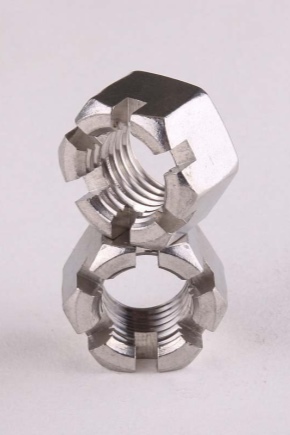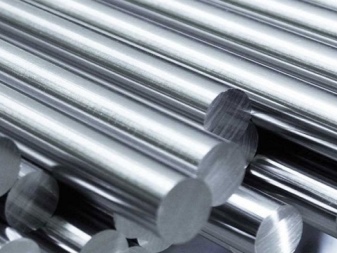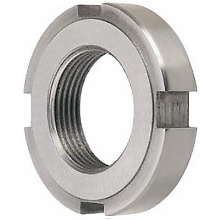All about slotted nuts

Knowing everything about slotted nuts is necessary not only for locksmiths, installers and other specialists, but also for ordinary people. Such products must comply with GOST 11871-88. And you will also have to deal with the socket heads of the slotted nuts, with round, lock and precision nuts, with the features of their marking and tightening. In this article, we'll take a look at everything about slotted nuts.

Peculiarities
The slotted nut is supplied by a wide variety of companies and is present in the range of all leading manufacturers. Technically, it is "just" a metal ring. A thread is applied to the hole of the product from the inside. In this case, special slots are applied outside, which gave the name to such fasteners. These grooves are formed using milling.
The role of the grooves is to ensure the scrolling of the hardware around its axis. The number of slots must correspond to the section of the product. Slotted hardware is rarely used for conventional threaded joints, but they are in great demand in various industries, namely:
- machine tool building;
- automotive industry;
- other branches of mechanical engineering.


These are primarily units that contain shafts and other intensively rotating parts. The load on the slotted fastener is very high, so it must be extremely reliable and stable. For its manufacture, only steel with a strength of at least 36 HRS is used. The minimum hardening depth is 0.1 cm.
Certain types of nuts are used in aggressive environments, therefore they are covered with special protective covers.


Requirements
Key points are fixed in GOST 11871-88. It applies to round splines of accuracy level A. The following points are normalized:
- nominal thread section;
- the step of applying this thread;
- number of slots;
- theoretical weight of the structure.



Inspection of nuts can be carried out primarily visually. In this case, magnifying devices are not used, but an illumination in the room of at least 300 lux is required. In difficult conditions, ordinary loops with a gain of 2.5–3 are used. In the description of control methods in standard 11871-88, references are made to other acts that define the following:
- study of tolerances and deviations from them;
- determination of the hardness of heat-treated metal;
- the order of comparison with roughness samples;
- rules for checking defects and applied coatings;
- level of permissible axle loads.


It is also useful to pay attention to GOST 11871-80. It covers round spline nuts with a thread cross section of 0.4–20 cm. Accuracy categories should be A or B. Finally, it is necessary to take a closer look at the 8530-90 standard, which defines the characteristics of nuts, washers and brackets for fixing and withdrawal sleeves. The size of the heads should be proportional to the diameter of the main section.
Thanks to the special grooves, it is easy and quick to install the nut in place. Dismantling it turns out to be no more difficult. What is important, the installation process takes place promptly even in rather difficult conditions. Locking round spline nuts is necessary using multi-blade washers. Such washers are equipped with external "legs", and one protrusion is located inside. For washers, the provisions of standard 11872 must be observed. It is worth noting that slotted hardware weighs significantly less than traditional hexagonal samples (with comparable parameters, of course). They also have smaller radial dimensions.

There are three key types of spline fasteners:
- no chamfer at all;
- with a simple chamfer;
- with a chamfer, but at the same time with a rounding.
Steel grade 14X17H2, 12X18H10T, 12X18H10T can be used as raw material. Such materials are taken to improve corrosion resistance. Under normal conditions, "simple" carbon steels of categories 20, 35 and 45 are preferred. Alloyed alloys 30KhGSA and 35Kh are applicable. Of brass, only L63 grade is suitable.
Steel grade 35 is used only for hardware with a thread of at least 0.6 and not more than 4.8 cm. It must certainly carry loads from 13.2 to 240.7 kN. This is the requirement for factory control recorded in the standard. Therefore, it is important to require the presentation of certificates with appropriate marks.
Popular hardware products treated with phosphate oil, zinc, a combination of cadmium and chromium.



Marking
The dimensions of the nominal thread diameter can be:
- 6;
- 8;
- 10;
- 12;
- 14;
- 16;
- 18;
- 56;
- 80;
- 95;
- 170;
- 200 mm (there are also other dimensions).

Fastener packaging shall include the following:
- official trademark (sometimes in combination with the name of the company);
- conventional signs of hardware;
- net weight or quantity in pieces.
Only fasteners of a completely uniform type may be inserted in each package. That is, if round models are placed there, then square and any other shapes cannot be used. The same applies to dimensions, materials and coatings used. For the manufacture of slotted nuts, either stainless steel or brass can be used. Various coatings can be applied over the stainless steel.
Lock washer nuts can range from HM 3044 to HM 3192. Another possible range is from HM 30/500 to HM 30/710. The mass of nuts in the marking is calculated on the assumption of a steel density of 7.85 g per 1 sq. see Sometimes it is practiced to apply not trapezoidal, but metric threads - which should also be marked.
Marking marks are applied to the end surface of the product.

How to twist them?
Perhaps the application is the most important point when it comes to slotted nuts. By default, they are used to fix strictly coaxial parts. It is common practice to use radius (also called collet) keys. They have a grip in the form of an arc, ending in a trailer that looks like a hook in appearance. Of course, there can be no question of using a screwdriver.
The state standard has fixed 21 key formats for any nuts. These keys are necessarily made of steel with the addition of chromium. A swivel tool is sometimes used. It is sufficient to have one key for each size group and apply it as needed. In some cases, socket heads help to work with slotted nuts.
They work even with a small space for fasteners and at the same time reduce the overall deformation of the products.

You can find out how to make a key for slotted nuts with your own hands from the video below.













The comment was sent successfully.